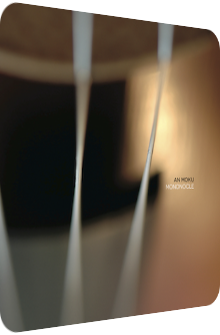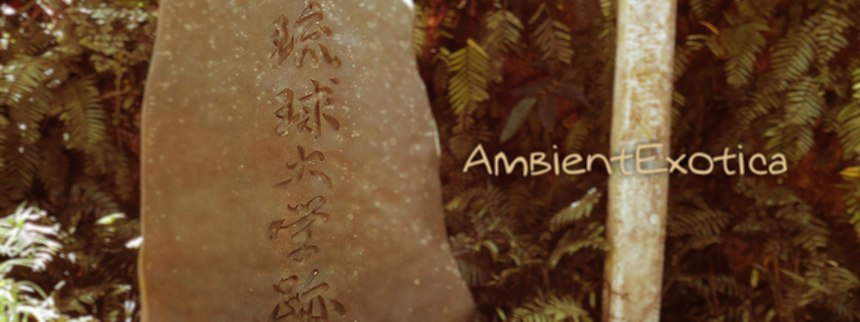
An Moku
Mononocle
2012
The Glitch genre is still alive and well, but has not gotten the attention it ought to have. Artists like Hanetration (London) and Heivard (Hong Kong) hold the flag up high and are close to my heart, but otherwise, the last years have been rather disappointing. Various best-of-lists on many blogs and websites did not even cite one single work. Drone artists were the clear winners. Luckily, there are still the iridescent Glitch or Clicks & Cuts gems of the late 90’s… and then there’s Zurich-based An Moku aka Dominik Grenzler with his latest album Mononocle, released in December 2012 on the Polish ETALABEL and available to purchase and listen to in full via this Bandcamp link. Mononocle is a five-track album whose base of existence is not necessarily all too focused on the Glitch genre – the label’s curator Grzegorz Bojanek does not even mention that particular genre in the album’s tag cloud – but more keen on a few Drone borrowings and Modern Classical artifacts. Violins and cellos are featured aplenty, but they are heavily processed and altered, evoking a ghostly aura that meshes with the coldness which is so typical for such records. Mononocle does not demand an experienced listener, but be aware that this is an album that is less about melodious hooks and euphonious interlockings than about the musical interlocution of its textures. Fizzles, sparkles and bleeps make up the soul of each track, and it is their different states of fragility, impetus and vehemence that cause much joy. As the liner notes state, "Mononocle is about transforming sounds and wooden noise. Hum, thunk and clunk. It is like listening to repeating sounds in different ways." Taking Dominik Grenzler’s impressive biography full of Iceland travels, Ruhr district band experiences and support performances for Joe Cocker (!) into account, it is no surprise that the artist pours the essences of these incidents and achievements into Mononocle.
Melting Point marks the point of departure of An Moku’s album, and given the many instruments and sources of noise, it makes for a great start and realizes that important first contact with the help of a supreme iciness; in this regard, the track title leads to the wrong path! Oscillating incessantly between the Drone and the Glitch genre, the analogue trait of the organ pads is much more eerie than it is warm, the clicking crackles and plinking slivers are high-plasticity devices that gurgle and scintillate in a fragile manner, and finally, there is this almost claustrophobic microscopic view onto the molecules that make up the soundscape which is highly intriguing. Microstoria’s Model 3, Step 2 (2000) comes to mind, as does Jan Jelinek’s aka Farben’s Bayreuth track off his Raw Macro EP (2000). The gelid ice flowers, the resonating ring and the bit-crushed machine burps altogether create a curiously hibernal panorama that lures the Glitch connoisseur with its auspicious consistency. The later phase of Melting Pot sees a New Age-resembling stream of pristine purity injected by An Moku, the peaceful but enigmatic gamelan-like aura increases and boosts the coldness to the maximum. Even more gruesome in this regard is the ensuing silence due to the meandering, meekly structure. Dominik Grenzler does not try to cover the crevasses of this composition, but grants the visibility of the backdrop of nothingness. This oxymoronic twist, a prospect full of naught, is the big success of the opener, its thinness refreshing.
The following Eremit, on the other hand, is much more progressive, as its layers carefully grow in density. Opening with a similarly cold stream of processed organs, there is actual snugness to be found thanks to the mildly ecclesial tone structure. The infinitesimal elasticity, the coercion of the differing half-tones works marvelously well, especially so since it is the only audible source for a long time. Only hesitantly do buzzes, clicks and sparkles enter the scenery. The surprising amount of their echo augments the wideness of this tune. Melting Point was bone-dry, but Eremit feels cavernous. After about four and a half minutes, a brazen haze is added. It is here that An Moku unchains the first bit of harshness and moves into Drone territory. The metallic nature of these saw blade drones cuts through the churchly aura, but remains somewhat genteel, never destroying the carefully built setup. The final third comprises of added shovel sounds, glistening flecks and a slow fadeout of the organ layer. As lively as Eremit becomes in the end, its slight tension does not turn into a turbulence. An Moku keeps the erudite contemplation formula intact. The third track, Kodama, is no different, but expands the echoes yet again. Grenzler creates a mystified vault with seraphic choir-resembling spectral synths and marries it with tick-tocking fingertips on wooden surfaces that sound a hundred times larger and punchier due to the applied effects. Various splutters and screeching blebs round off the track. While Kodama remains true to the intrinsic soundscape, it is a bit too dynamic and hectic in the given prospects, but that is up for debate, especially so since a graceful peacefulness is once more omnipresent. The duality and counterpoise-driven nature, however, becomes specifically apparent here.
Up next is Stockwerk (translatable as floor), and it is a centerpiece if there ever was one! 45 minutes of Glitch await the listener in this enormously detailed, ever-shifting and acroamatic critter. It launches in a similarly cold way as Melting Point, adds another dose of bit-crushed metal to it and interpolates the impetus of the synth streams. But there are surprises in store that are unique to the aural color palette An Moku has used heretofore. Of particular success are the euphonious droplets that sound like short selection or menu jingles found in operating systems, mobile phones or video games when a certain setting is chosen. They sound very charming or embracing and are so unlike the deliberately serious undertone of the album. It is hard to describe for me as you can see, but these little droplets are undoubtedly enchanting. Then there is the sudden appearance of an interwoven piano arrangement vignette. The tonality is amicable, aqueous and even joyful. Koto-like violin strings and sudden rockfall ennoble this short interlude. Stockwerk continues to shift its shape, but remains in high frequency glitchy waters. Although it revs up the dynamics with hollow, epicurean polyphonous strings and moves to thought-provoking Asian keys of solemnity, the various fluttering splinters and vinyl-like bits as well as the darker undertones remind of the setting in which Stockwerk is embedded. The track thankfully ends on an expanding lachrymosity full of accessible synth strings and a circumambient coruscation of polished vesicles. Why Dominik Grenzler did not divide the various parts into selectable tracks is beyond me. Stockwerk is a great piece, but it does not necessarily become more meaningful in its stretched form. Its changing patterns and missing leitmotif suggest and nurture such thoughts. The final composition is called Oko. A particularly abyssal drone layer is its signature force. The first two minutes are very dark and arcane, but the turquoise-tinged lucency of the altered violin strings soon provides a source of illumination. Blurry cello figments and ghostly croaks turn Oko into a dripstone cave. The final Far Eastern plucks of elusive string instruments put the album to an end.
The following sentence might sound audacious, but my intentions are encouraging: Mononocle is a wondrously retrogressive album. And that is a very good thing. It harks back to the late 90’s and early 00’s with their jitter-heavy, ice-fueled, crystalline-structured Glitchscapes of the most fragile order. Dominik Grenzler harks back to that certain point in time where analogue warmth was not the sole driving factor anymore, but deferred and placed back for short infusions of euphony in-between the grinding, bedazzling blazes of high-pitched hi-hats, coercible cymbals and thumping bass drops. Mononocle is thus a feast for experienced Glitch listeners; and yet it is accessible. The term accessibility is a double-edged sword in the field of electronic music, for there are many schools of thought gyrating around the notion of streamlined bindings and a forceful eclecticism. An Moku’s arrangements are torn between these differing viewpoints, but not torn apart by them. The interplay of the many sounds and their fight against the threatening emptiness in the background makes for a highly enjoyable, reflective listening experience. Another marker of the late 90’s consists of the huge amount of surfaces and textures. While all tracks retain a certain arc and mood, the uncountable bubbles, blisters, particles and specks all have their certain tinge and hue. As every well-balanced Glitch album shows, there is a gradual transition taking place in terms of the ubiquitous coldness. Once the listener adjusts to the frosty insinuations, he or she can unravel and dissect the counteroffensive sections in the form of analogue equipment, real instruments or other creative outbursts. All of a sudden, the tiny dependencies and subordinations of the admixed ingredients become clear as they get detached from the surrounding forces. Such operations rely on density, and An Moku’s Mononocle delivers big time. What it lacks in hummable melodies – only Stockwerk harbors a classic piano arrangement in its nucleus – it delivers with its cornucopia of textures. Glitch fans who long for the good old times, you know what to do.
Further listening and reading:
You can purchase and listen to An Moku’s Mononocle in full via this Bandcamp link.
Ambient Review 175: An Moku – Mononocle (2012). Originally published on Jan. 23, 2013 at AmbientExotica.com.
